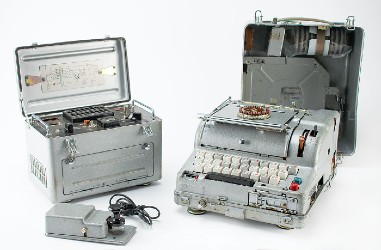
BOSTON – An original Cold War-era Russian M-125 cipher machine, codenamed “Fialka,” sold for $22,000 in RR Auction’s Science & Technology and Space Exploration online auction that closed July 16. View the fully illustrated catalog with prices realized on LiveAuctioneers.
The Fialka is an electromechanical, wheel-based code-generating and decoding machine. Its development came after World War II and was based loosely on the German Enigma machine, with rotors moving to a new position each time a key is pressed, creating a new electrical circuit and an alphabetic substitution for the letter pressed. However, the Fialka (above) incorporates a number of different features from the Enigma that made it a much more daunting cipher-generating machine. These features include the use of 10 rotors (each with 30 contacts), wheels rotating in opposite directions, and more frequent wheel stepping. In addition, the rotors could be quickly rewired in the field, and input and output from the machine was accelerated via the use of punched paper tape. This example has ten rotors installed in the device’s drum, and an additional set of ten spare rotors held inside the case’s lid, plus one single extra rotor.
Being regularly produced starting in 1956, the Fialka quickly became a primary cipher machine for all Warsaw Pact countries and Cuba. Each country had the Fialka keyboard modified to their language—this example has Cyrillic and Latin characters—and had specially wired rotors. The Fialka was in use by Russia and its allies well into the 1990s, and little information was available about this machine until 2005 as it had been kept secret. Few Fialka machines remain as the Soviet Union and its successors systematically destroyed them as the machines have been taken out of service.
“It’s an important piece of Cold War code-making history,” said Bobby Livingston, executive vice president at RR Auction.

Highlights from the sale included:
– Ed Gibson’s Apollo 17 Flown Robbins Medal sold for $50,907.
– An Alan Turing handwritten and signed postcard sold for $35,000.
– Apollo 15 Lunar surface flown American flag sold for $35,251.
– Buzz Aldrin’s Apollo 11-flown, crew-signed Type 1 ‘Quarantine’ cover sold for $30,818.
– Michael Collins’s Apollo 11-flown, crew-signed Beta patch sold for $30,818.
– Edgar Mitchell’s Apollo 14-flown Lunar Module spoon sold for $30,000.
– Russian N-1 moon rocket model sold for $25,285.
– Apollo Lunar Landing Training Vehicle (LLTV)-flown rocket engine sold for $17,046.
[av_button label=’View the fully illustrated catalog with prices realized.’ link=’manually,https://www.liveauctioneers.com/catalog/173588_science-and-technology-and-space-exploration/’ link_target=’_blank’ size=’medium’ position=’center’ label_display=” title_attr=” icon_select=’no’ icon=’ue800′ font=’entypo-fontello’ color=’theme-color’ custom_bg=’#444444′ custom_font=’#ffffff’ av_uid=’av-9511hts’ id=” custom_class=” admin_preview_bg=”]
View top auction results on LiveAuctioneers here: https://www.liveauctioneers.com/pages/recent-auction-sales/


